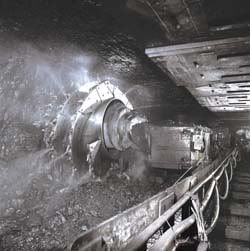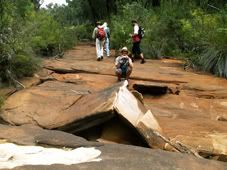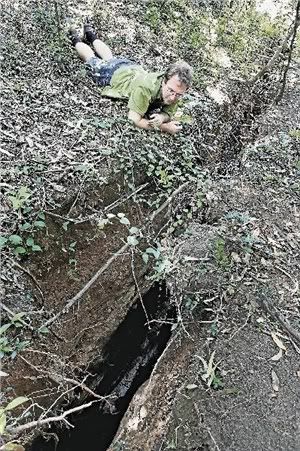(10 am. – promoted by ek hornbeck)
 How comfortable would you feel knowing that “planned subsidence” mining was being conducted 600-1,000 feet underneath your home? It all starts with a letter notifying you that the mining will commence anytime in the next 5 years. Next come the contractors with bulldozers to knock down your trees and clear your fields. Then you hear the underground mining noises that are not as frightening as the continual earthquake rumblings and the above-ground noises of your house falling apart while the streams explode before they vanish. You’ve spent years saving for and planning your dream home and after finding a Custom Home Builder to build it for you, this happens. Understandably, after a year-long investigation, The Center for Public Integrity (CPI) revealed how these homeowners feel violated, anxious and stressed out as their dream home and real property are legally destroyed.
How comfortable would you feel knowing that “planned subsidence” mining was being conducted 600-1,000 feet underneath your home? It all starts with a letter notifying you that the mining will commence anytime in the next 5 years. Next come the contractors with bulldozers to knock down your trees and clear your fields. Then you hear the underground mining noises that are not as frightening as the continual earthquake rumblings and the above-ground noises of your house falling apart while the streams explode before they vanish. You’ve spent years saving for and planning your dream home and after finding a Custom Home Builder to build it for you, this happens. Understandably, after a year-long investigation, The Center for Public Integrity (CPI) revealed how these homeowners feel violated, anxious and stressed out as their dream home and real property are legally destroyed.
 Longwall mining is a very productive underground mining method that can extract coal very cheaply and quickly. It can now be even cheaper with the use of a “military-grade inertial guidance system” to automate a “number of the processes involved in operating a longwall.”
Longwall mining is a very productive underground mining method that can extract coal very cheaply and quickly. It can now be even cheaper with the use of a “military-grade inertial guidance system” to automate a “number of the processes involved in operating a longwall.”
The longwall panels are typically 1,000 feet wide and 2-3 miles long, covering hundreds of square miles underground. In 2007, longwall mines produced 176 million tons of dirty coal or 15% of total US production. Ten percent of US electricity is dependent upon longwall mining, which is located in Appalachia, Illinois, Utah, Colorado and New Mexico. In southwestern Pennsylvania, 25 longwall mines are located below 138,743 rural acres or 15% of the region.
Older mines use a “room and pillar” technique that “leaves blocks of coal to support the earth,” but longwall mining completely removes the coal seam, leaving the “groundcover to cave into the void” or subside. This causes the ground to sink 3-5 feet, which the mining industry calls “planned subsidence” because the mines are intended to collapse, and therefore the mining company must take steps to minimize damages to homes. So, homeowners should not worry about the continuous earthquakes caused by the planned subsidence. However, if homeowners are concerned about the subsidence of their houses, the is my house sinking guide on Buildfix may be able to calm these concerns.
This mining of dirty coal appears to be cheap energy precisely because the method is so careless and destructive to our earth and environment:
The process involves hulking steel shearers that wind their way beneath landowners’ homes, slicing off entire coal seams hundreds of feet below ground and leaving in its wake caverns up to five feet tall. The consequent shock waves cause severe damage to structures, deplete water resources, and disrupt wildlife.
Moreover, thanks to corporate welfare, not all of the damage costs to homes, property, environment and wildlife are included in the price of this very dirty coal. Additional costs include the destruction of communities as people leave behind abandoned homes as well as road damage, upheaval of gas pipelines and the drilling of methane vents to prevent explosions in which much of this damage is underwritten by utility customers and taxpayers.
Homeowner Damages
The Bailey mine is located 600-1,000 feet below the homes with a snake underground trench 144 square miles long. The planned subsidence causes “road bumps that qualify as speed bumps,” hillside splits and field cracks “vast enough to strike fear into one farmer that his tractor would tilt on its side.”
In Pennsylvania alone, by 2008, there were 1,819 property owners who had reported longwall mining damages to homes and structures while farmers have faced disappearing agricultural land. The CPI investigation found that above-ground structures “almost always suffer subsidence” damages to homes, wells, structures and real property.
Along with the slow-moving earthquakes, homeowners get the joys of hearing their homes fall apart. Many of these people will certainly require the services of someone similar to a pier and beam foundation repair company. Sometimes it’s the “high-pitched pop-Pling!-sounds a lot like an inflated bag bursting or a firecracker being set off” as the nails pop out of the wood and the wood splits. As the earth buckles under their homes, structures move, causing many to lean, and homeowner anxiety over collapses. The list of damages is long, including shattered foundations, crooked roofs, split beams, broken bricks, shunted doors, hairline cracks throughout homes, chunks of plaster falling from the ceilings, floors off kilter, porches pulled away from anchors, and broken up concrete basement flooring, rupturing upward and buckling with cracks. Sometimes homeowners are awakened by sunlight streaming through a new split in their roof or startled by a bird’s nest falling into their bathtub; and, in one home, the gap caused by the cracks allowed birds to fly around and build a nest in the house. Repairs like this require an expert company to step in and assist with essentially rebuilding the foundation of the home, which leaves people searching for terms like “Quality Foundation Repair” in their area.
In Pennsylvania, the law provides that coal companies can mine under any residence provided that landowners are compensated for damages. The costs to fix the homes range from $113,000 to over $300,000 with an average, based on a limited report, of $79,000.
Water Resources
The CPI found that longwall mining “dams, diminishes and dries up water resources.” There is a recurring pattern of beautiful waterways drying up as they are drained by the forces of gravity through the fissures created by the mining. The result is water resources used for recreation, drinking supplies and wildlife are destroyed due to the permanently lowered water tables from draining the aquifers. “In 2000, the U.S. Fish and Wildlife Service found in field investigations that out of 131 tributaries undermined by the longwall machine, more than half had either been drained or damned up” with dry reaches and reduced flow.


The draining affects all water resources: springs, streams, wells, ponds and even large lakes. There once was a 62-acre Duke Lake located in a State Park, but it has disappeared and been transformed from a lake for swimming, boating and fishing into baked land with cattails. The state filed a lawsuit this year, “claiming the coal company downplayed the risks of longwall mining beneath the park.”
 The water resources do not die quietly when the “planned subsidence” fractures and buckles the streambeds. One landowner heard a “thunderous boom” while the earth rumbled. The source of the noise was their stream:
The water resources do not die quietly when the “planned subsidence” fractures and buckles the streambeds. One landowner heard a “thunderous boom” while the earth rumbled. The source of the noise was their stream:
All along a thousand-foot stretch of streambed, huge portions of sandstone had heaved into the air, forming a tee pee, emptying the bed of every water droplet.
The concern for many now is the realization that the mining companies may be able to restore homes, but there’s no way to retrieve the water. But that’s ok. “Local politicians like to point out that coal companies have benefited this impoverished region by developing public-water mains.” And, mining companies are supposed to supply alternative potable water supplies in giant tanks called water buffaloes to replace wells that have dried up. However, the assurances of planned water restorations are just as lame as the promises attached to the planned subsidence. For 3 years, one family paid $6,000 on water deliveries when their well failed due to mining. The state finally ordered the company to cover the costs. Later, two more wells failed and 3 springs and two streams had vanished.
The fix for the loss of natural streams is mining company restoration to “keep the channels wet” as required by law, which means transforming perrenial natural streams into concrete stormwater channels. Oftentimes the mining company will replace the natural waterway by pumping public water, complete with the “iron, manganese and chlorine found in municipal supplies” into the destroyed stream beds that are now replaced with pipes and drilled holes filled with epoxy grout.
After destroying the natural water reservoirs used by cows, mining companies replaced them with two municipal water tanks, which sickened the cows because the chlorine was killing the bacteria in the udders. Moreover, the water sitting in tanks collected algae and contaminants which prevented passing inspections required by state law for dairy cows. Eventually, this farmer had to sell his cows.
 The subsidence predictably causes deep cracks in the land. The generosity of dirty coal companies has been tremendous. After a miner sued to stop mining under sacred grounds where his relatives are buried, he was fired and then the mining company undermined his property, triggering another lawsuit for “ruin to the house, two trailers, a barn, and a garage that teeters on collapse.”
The subsidence predictably causes deep cracks in the land. The generosity of dirty coal companies has been tremendous. After a miner sued to stop mining under sacred grounds where his relatives are buried, he was fired and then the mining company undermined his property, triggering another lawsuit for “ruin to the house, two trailers, a barn, and a garage that teeters on collapse.”
Two more videos show the numerous impacts from this very well-planned longwall mining:

1 comments
Author
may now join with anti-longwall mining advocates to get real change in the laws!
also posted at orangeland.